Analyse of Slope Stability Using Bishop Method
VerifiedAdded on 2022/10/13
|6
|729
|30
AI Summary
Contribute Materials
Your contribution can guide someone’s learning journey. Share your
documents today.
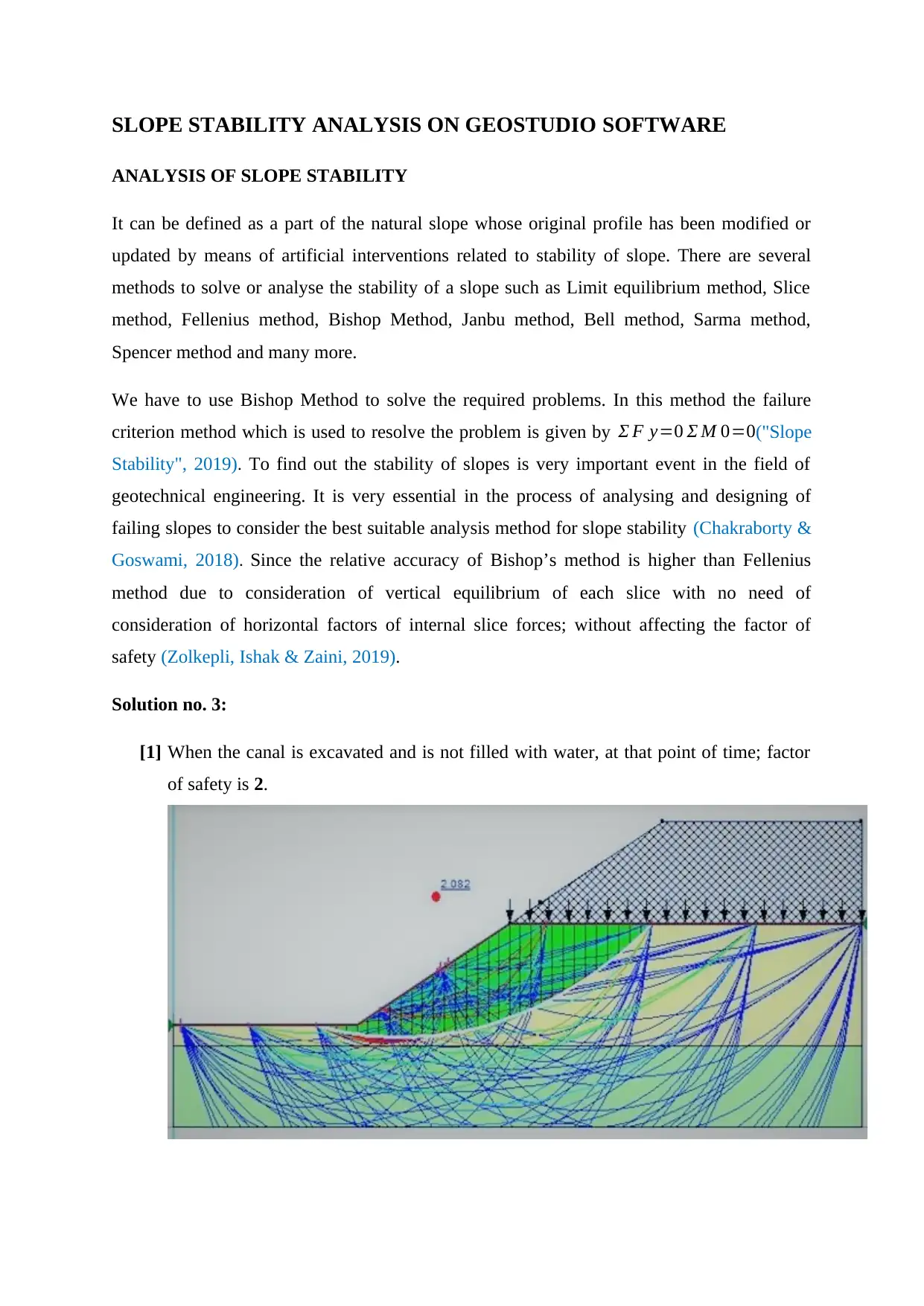
SLOPE STABILITY ANALYSIS ON GEOSTUDIO SOFTWARE
ANALYSIS OF SLOPE STABILITY
It can be defined as a part of the natural slope whose original profile has been modified or
updated by means of artificial interventions related to stability of slope. There are several
methods to solve or analyse the stability of a slope such as Limit equilibrium method, Slice
method, Fellenius method, Bishop Method, Janbu method, Bell method, Sarma method,
Spencer method and many more.
We have to use Bishop Method to solve the required problems. In this method the failure
criterion method which is used to resolve the problem is given by Σ F y=0 Σ M 0=0("Slope
Stability", 2019). To find out the stability of slopes is very important event in the field of
geotechnical engineering. It is very essential in the process of analysing and designing of
failing slopes to consider the best suitable analysis method for slope stability (Chakraborty &
Goswami, 2018). Since the relative accuracy of Bishop’s method is higher than Fellenius
method due to consideration of vertical equilibrium of each slice with no need of
consideration of horizontal factors of internal slice forces; without affecting the factor of
safety (Zolkepli, Ishak & Zaini, 2019).
Solution no. 3:
[1] When the canal is excavated and is not filled with water, at that point of time; factor
of safety is 2.
ANALYSIS OF SLOPE STABILITY
It can be defined as a part of the natural slope whose original profile has been modified or
updated by means of artificial interventions related to stability of slope. There are several
methods to solve or analyse the stability of a slope such as Limit equilibrium method, Slice
method, Fellenius method, Bishop Method, Janbu method, Bell method, Sarma method,
Spencer method and many more.
We have to use Bishop Method to solve the required problems. In this method the failure
criterion method which is used to resolve the problem is given by Σ F y=0 Σ M 0=0("Slope
Stability", 2019). To find out the stability of slopes is very important event in the field of
geotechnical engineering. It is very essential in the process of analysing and designing of
failing slopes to consider the best suitable analysis method for slope stability (Chakraborty &
Goswami, 2018). Since the relative accuracy of Bishop’s method is higher than Fellenius
method due to consideration of vertical equilibrium of each slice with no need of
consideration of horizontal factors of internal slice forces; without affecting the factor of
safety (Zolkepli, Ishak & Zaini, 2019).
Solution no. 3:
[1] When the canal is excavated and is not filled with water, at that point of time; factor
of safety is 2.
Secure Best Marks with AI Grader
Need help grading? Try our AI Grader for instant feedback on your assignments.
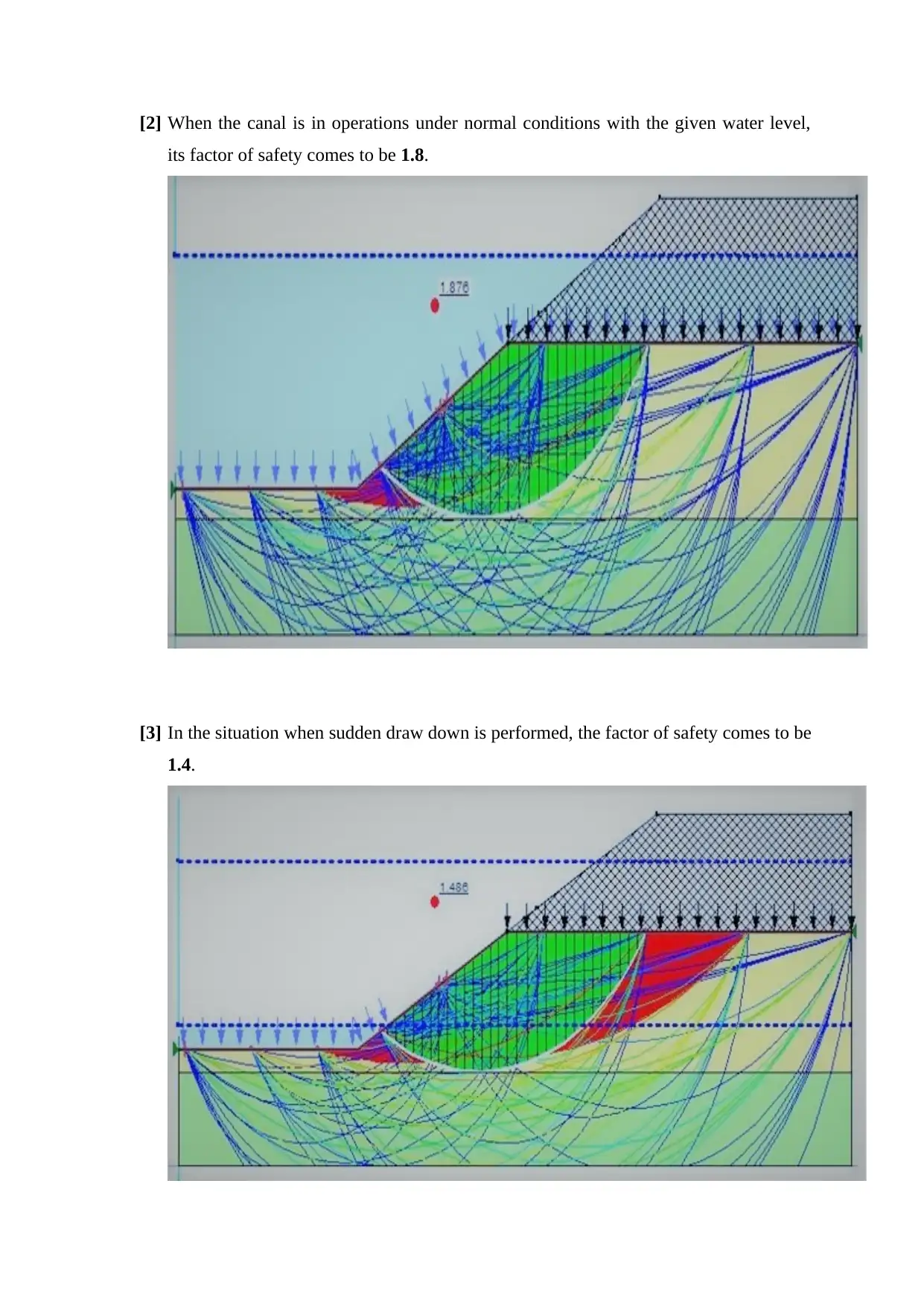
[2] When the canal is in operations under normal conditions with the given water level,
its factor of safety comes to be 1.8.
[3] In the situation when sudden draw down is performed, the factor of safety comes to be
1.4.
its factor of safety comes to be 1.8.
[3] In the situation when sudden draw down is performed, the factor of safety comes to be
1.4.
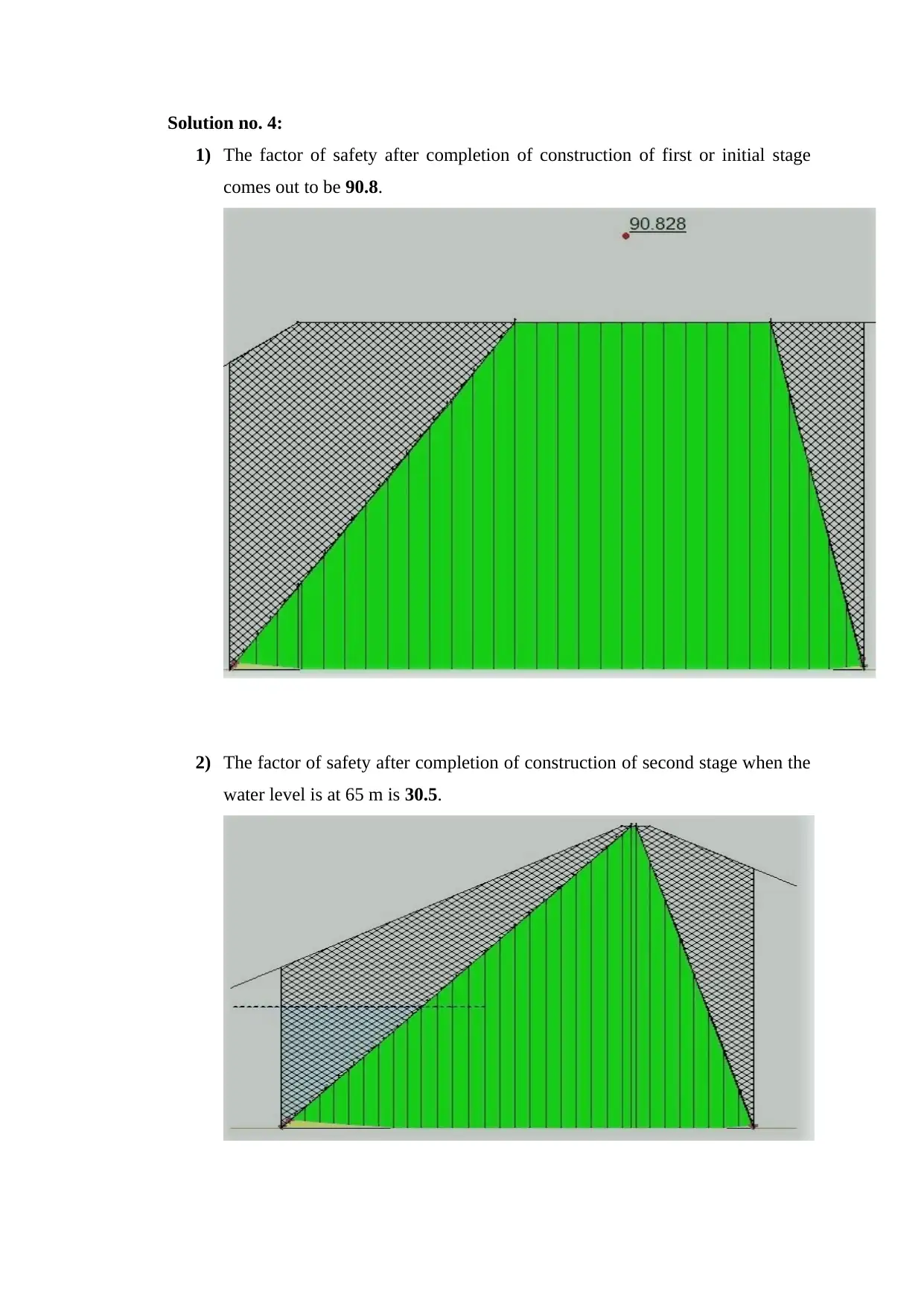
Solution no. 4:
1) The factor of safety after completion of construction of first or initial stage
comes out to be 90.8.
2) The factor of safety after completion of construction of second stage when the
water level is at 65 m is 30.5.
1) The factor of safety after completion of construction of first or initial stage
comes out to be 90.8.
2) The factor of safety after completion of construction of second stage when the
water level is at 65 m is 30.5.
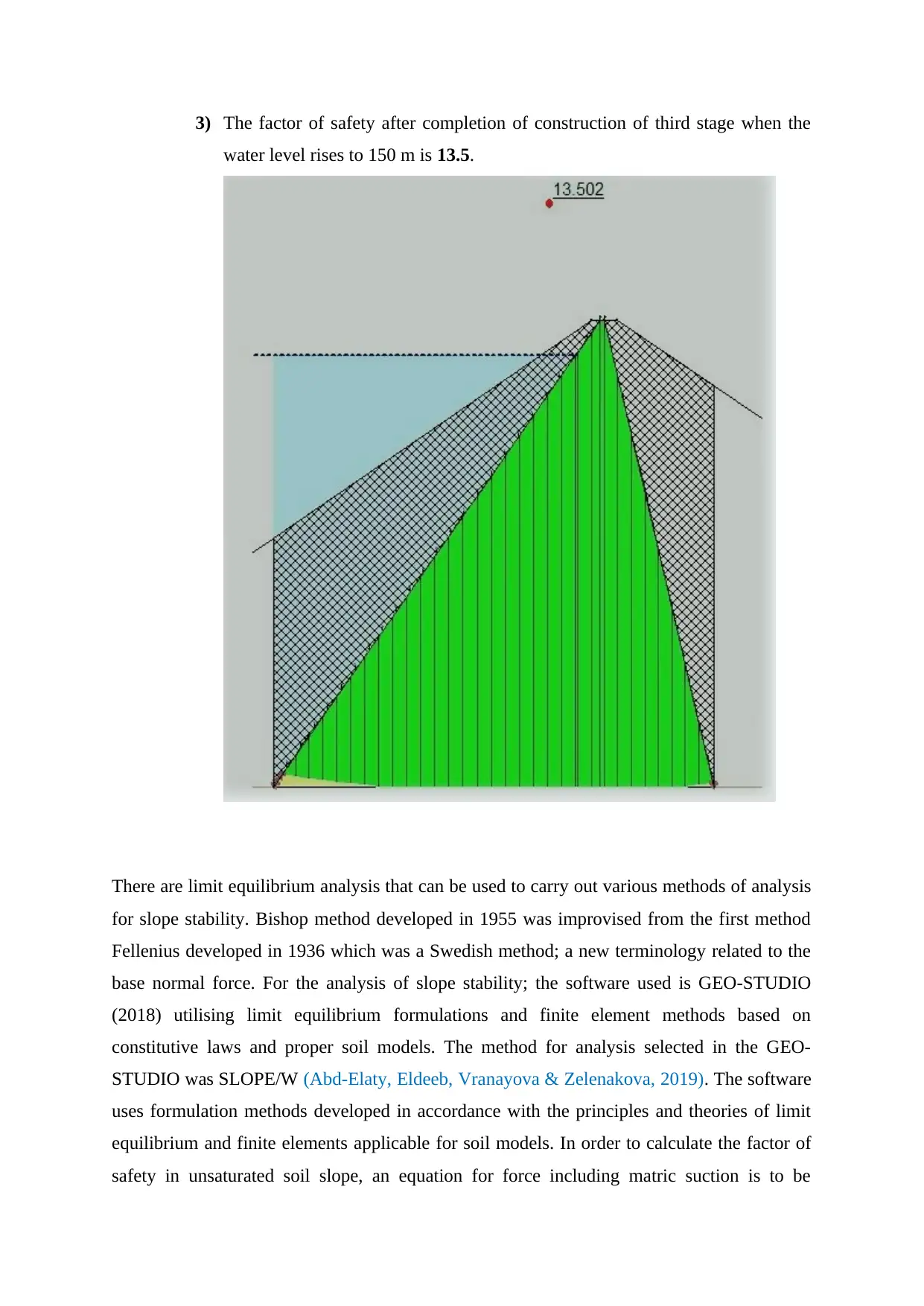
3) The factor of safety after completion of construction of third stage when the
water level rises to 150 m is 13.5.
There are limit equilibrium analysis that can be used to carry out various methods of analysis
for slope stability. Bishop method developed in 1955 was improvised from the first method
Fellenius developed in 1936 which was a Swedish method; a new terminology related to the
base normal force. For the analysis of slope stability; the software used is GEO-STUDIO
(2018) utilising limit equilibrium formulations and finite element methods based on
constitutive laws and proper soil models. The method for analysis selected in the GEO-
STUDIO was SLOPE/W (Abd-Elaty, Eldeeb, Vranayova & Zelenakova, 2019). The software
uses formulation methods developed in accordance with the principles and theories of limit
equilibrium and finite elements applicable for soil models. In order to calculate the factor of
safety in unsaturated soil slope, an equation for force including matric suction is to be
water level rises to 150 m is 13.5.
There are limit equilibrium analysis that can be used to carry out various methods of analysis
for slope stability. Bishop method developed in 1955 was improvised from the first method
Fellenius developed in 1936 which was a Swedish method; a new terminology related to the
base normal force. For the analysis of slope stability; the software used is GEO-STUDIO
(2018) utilising limit equilibrium formulations and finite element methods based on
constitutive laws and proper soil models. The method for analysis selected in the GEO-
STUDIO was SLOPE/W (Abd-Elaty, Eldeeb, Vranayova & Zelenakova, 2019). The software
uses formulation methods developed in accordance with the principles and theories of limit
equilibrium and finite elements applicable for soil models. In order to calculate the factor of
safety in unsaturated soil slope, an equation for force including matric suction is to be
Secure Best Marks with AI Grader
Need help grading? Try our AI Grader for instant feedback on your assignments.

established along with the shear force of a slice that can be introduced as: (Sm= τl
F ) . when
the matric suction tends to zero, it illustrates that soil is saturated and the final equation
becomes same as the original equation of Bishop method. All the Factors of safety has been
introduced in the file above acquired from the process of methods applied.
F ) . when
the matric suction tends to zero, it illustrates that soil is saturated and the final equation
becomes same as the original equation of Bishop method. All the Factors of safety has been
introduced in the file above acquired from the process of methods applied.
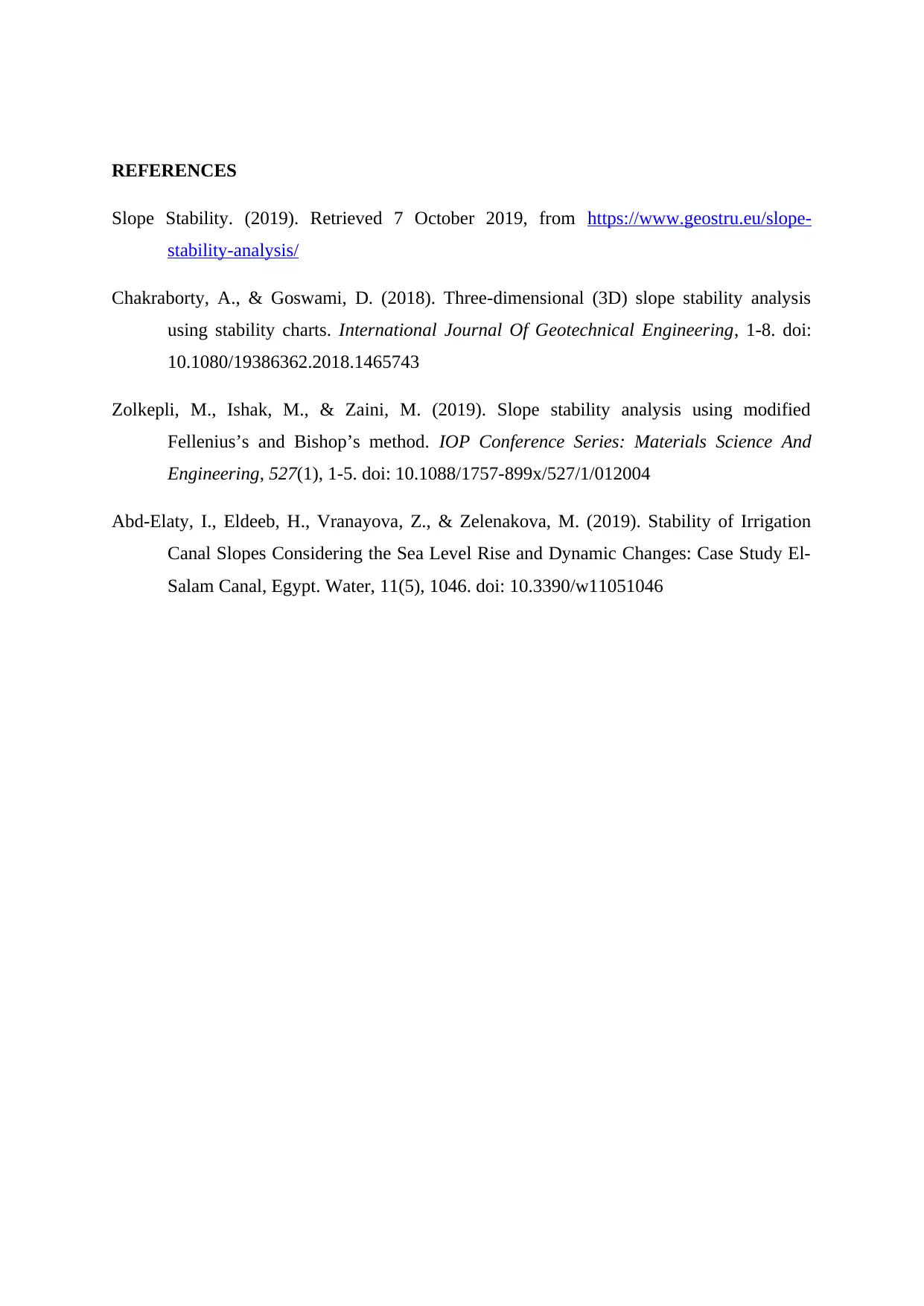
REFERENCES
Slope Stability. (2019). Retrieved 7 October 2019, from https://www.geostru.eu/slope-
stability-analysis/
Chakraborty, A., & Goswami, D. (2018). Three-dimensional (3D) slope stability analysis
using stability charts. International Journal Of Geotechnical Engineering, 1-8. doi:
10.1080/19386362.2018.1465743
Zolkepli, M., Ishak, M., & Zaini, M. (2019). Slope stability analysis using modified
Fellenius’s and Bishop’s method. IOP Conference Series: Materials Science And
Engineering, 527(1), 1-5. doi: 10.1088/1757-899x/527/1/012004
Abd-Elaty, I., Eldeeb, H., Vranayova, Z., & Zelenakova, M. (2019). Stability of Irrigation
Canal Slopes Considering the Sea Level Rise and Dynamic Changes: Case Study El-
Salam Canal, Egypt. Water, 11(5), 1046. doi: 10.3390/w11051046
Slope Stability. (2019). Retrieved 7 October 2019, from https://www.geostru.eu/slope-
stability-analysis/
Chakraborty, A., & Goswami, D. (2018). Three-dimensional (3D) slope stability analysis
using stability charts. International Journal Of Geotechnical Engineering, 1-8. doi:
10.1080/19386362.2018.1465743
Zolkepli, M., Ishak, M., & Zaini, M. (2019). Slope stability analysis using modified
Fellenius’s and Bishop’s method. IOP Conference Series: Materials Science And
Engineering, 527(1), 1-5. doi: 10.1088/1757-899x/527/1/012004
Abd-Elaty, I., Eldeeb, H., Vranayova, Z., & Zelenakova, M. (2019). Stability of Irrigation
Canal Slopes Considering the Sea Level Rise and Dynamic Changes: Case Study El-
Salam Canal, Egypt. Water, 11(5), 1046. doi: 10.3390/w11051046
1 out of 6
Your All-in-One AI-Powered Toolkit for Academic Success.
+13062052269
info@desklib.com
Available 24*7 on WhatsApp / Email
![[object Object]](/_next/static/media/star-bottom.7253800d.svg)
Unlock your academic potential
© 2024 | Zucol Services PVT LTD | All rights reserved.

